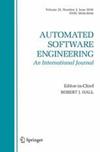GenerativeGI: creating generative art with genetic improvement
Abstract
Generative art is a domain in which artistic output is created via a procedure or heuristic that may result in digital and/or physical results. A generative artist will typically act as a domain expert by specifying the algorithms that will form the basis of the piece as well as defining and refining parameters that can impact the results, however such efforts can require a significant amount of time to generate the final output. This article presents and extends GenerativeGI, an evolutionary computation-based technique for creating generative art by automatically searching through combinations of artistic techniques and their accompanying parameters to produce outputs desirable by the designer. Generative art techniques and their respective parameters are encoded within a grammar that is then the target for genetic improvement. This grammar-based approach, combined with a many-objective evolutionary algorithm, enables the designer to efficiently search through a massive number of possible outputs that reflect their aesthetic preferences. We included a total of 15 generative art techniques and performed three separate empirical evaluations, each of which targets different aesthetic preferences and varying aspects of the search heuristic. Experimental results suggest that GenerativeGI can produce outputs that are significantly more novel than those generated by random or single objective search. Furthermore, GenerativeGI produces individuals with a larger number of relevant techniques used to generate their overall composition.



 求助内容:
求助内容: 应助结果提醒方式:
应助结果提醒方式:


